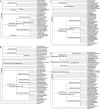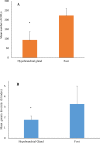Characterization of Bacterial Communities Associated with the Tyrian Purple Producing Gland in a Marine Gastropod
- PMID: 26488885
- PMCID: PMC4619447
- DOI: 10.1371/journal.pone.0140725
Characterization of Bacterial Communities Associated with the Tyrian Purple Producing Gland in a Marine Gastropod
Abstract
Dicathais orbita is a marine mollusc recognised for the production of anticancer compounds that are precursors to Tyrian purple. This study aimed to assess the diversity and identity of bacteria associated with the Tyrian purple producing hypobranchial gland, in comparison with foot tissue, using a high-throughput sequencing approach. Taxonomic and phylogenetic analysis of variable region V1-V3 of 16S rRNA bacterial gene amplicons in QIIME and MEGAN were carried out. This analysis revealed a highly diverse bacterial assemblage associated with the hypobranchial gland and foot tissues of D. orbita. The dominant bacterial phylum in the 16S rRNA bacterial profiling data set was Proteobacteria followed by Bacteroidetes, Tenericutes and Spirochaetes. In comparison to the foot, the hypobranchial gland had significantly lower bacterial diversity and a different community composition, based on taxonomic assignment at the genus level. A higher abundance of indole producing Vibrio spp. and the presence of bacteria with brominating capabilities in the hypobranchial gland suggest bacteria have a potential role in biosynthesis of Tyrian purple in D. orbita.
Conflict of interest statement
Figures






Similar articles
-
Transcriptome of the Australian Mollusc Dicathais orbita Provides Insights into the Biosynthesis of Indoles and Choline Esters.Mar Drugs. 2016 Jul 20;14(7):135. doi: 10.3390/md14070135. Mar Drugs. 2016. PMID: 27447649 Free PMC article.
-
Bromoperoxidase Producing Bacillus spp. Isolated from the Hypobranchial Glands of a Muricid Mollusc Are Capable of Tyrian Purple Precursor Biogenesis.Mar Drugs. 2019 May 3;17(5):264. doi: 10.3390/md17050264. Mar Drugs. 2019. PMID: 31058830 Free PMC article.
-
Comparative analysis of gut bacterial communities of green turtles (Chelonia mydas) pre-hospitalization and post-rehabilitation by high-throughput sequencing of bacterial 16S rRNA gene.Microbiol Res. 2018 Mar;207:91-99. doi: 10.1016/j.micres.2017.11.010. Epub 2017 Nov 21. Microbiol Res. 2018. PMID: 29458874
-
Highly diverse microbiota in dental root canals in cases of apical periodontitis (data of illumina sequencing).J Endod. 2014 Nov;40(11):1778-83. doi: 10.1016/j.joen.2014.06.017. Epub 2014 Sep 16. J Endod. 2014. PMID: 25227214
-
Natural product research in the Australian marine invertebrate Dicathais orbita.Mar Drugs. 2013 Apr 23;11(4):1370-98. doi: 10.3390/md11041370. Mar Drugs. 2013. PMID: 23612370 Free PMC article. Review.
Cited by
-
Host-Microbe Coevolution: Applying Evidence from Model Systems to Complex Marine Invertebrate Holobionts.mBio. 2019 Feb 5;10(1):e02241-18. doi: 10.1128/mBio.02241-18. mBio. 2019. PMID: 30723123 Free PMC article. Review.
-
Extraction and Quantification of Bioactive Tyrian Purple Precursors: A Comparative and Validation Study from the Hypobranchial Gland of a Muricid Dicathais orbita.Molecules. 2016 Dec 5;21(12):1672. doi: 10.3390/molecules21121672. Molecules. 2016. PMID: 27929402 Free PMC article.
-
Diversity of the Tryptophanase Gene and Its Evolutionary Implications in Living Organisms.Microorganisms. 2021 Oct 15;9(10):2156. doi: 10.3390/microorganisms9102156. Microorganisms. 2021. PMID: 34683477 Free PMC article.
-
Transcriptome of the Australian Mollusc Dicathais orbita Provides Insights into the Biosynthesis of Indoles and Choline Esters.Mar Drugs. 2016 Jul 20;14(7):135. doi: 10.3390/md14070135. Mar Drugs. 2016. PMID: 27447649 Free PMC article.
-
Bromoperoxidase Producing Bacillus spp. Isolated from the Hypobranchial Glands of a Muricid Mollusc Are Capable of Tyrian Purple Precursor Biogenesis.Mar Drugs. 2019 May 3;17(5):264. doi: 10.3390/md17050264. Mar Drugs. 2019. PMID: 31058830 Free PMC article.
References
-
- Westley C, Benkendorff K. Sex-specific Tyrian purple genesis: precursor and pigment distribution in the reproductive system of the marine mollusc, Dicathais orbita . J Chem Ecol. 2008; 34: 44–56. - PubMed
-
- Cooksey CJ. Tyrian purple: 6,6’-dibromoindigo and related compounds. Molecules 2001; 6: 736–769.
-
- Benkendorff K, Bremner JB, Davis AR. Tyrian purple precursors in the egg masses of the Australian muricid, Dicathais orbita: A possible defensive role. J Chem Ecol. 2000; 26: 1037–1050.
-
- Westley CB, McIver CM, Abbott CA, Le Leu RK, Benkendorff K. Enhanced acute apoptotic response to azoxymethane-induced DNA damage in the rodent colonic epithelium by Tyrian purple precursors: A potential colorectal cancer chemopreventative. Cancer Biol Ther. 2010; 9: 371–379. - PubMed
MeSH terms
Substances
LinkOut - more resources
Full Text Sources
Other Literature Sources
Miscellaneous

